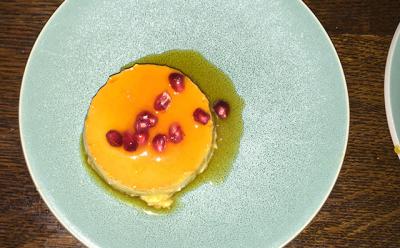Seasons by the Sea: Christmas Eve Traditions

Christmas, Christmas, Christmas. Enough about Christmas and the music and the decorating and how many more shopping days we have until the big day. To my mind, some of the more interesting aspects of this massive holiday are the Christmas Eve food traditions celebrated by different cultures. There is Noche Buena, celebrated throughout Latin America; Kucios, the traditional dinner served in Lithuania, and, for Italian Americans, Esta dei Sette Pesce, or Feast of the Seven Fishes. (I assume Dec. 24 is the only day that “fishes” is grammatically correct?)
The rituals that accompany Kucios are many and varied, some solemn, some amusing. It is important that as many family members as possible make the effort to travel to be together for this evening. A handful of hay is laid upon the table before a white tablecloth is placed over it. The hay represents baby Jesus being born in a stable. If a family member has died within the past year, a place setting without silverware is laid out for that person with a candle upon the plate. The candle is lit throughout the meal in their memory.
The meal begins when the first star in the sky appears, representing the Star of Bethlehem. There are fir boughs and candles for decoration but no live flowers. Plotkeles, wafers similar to Communion hosts, are shared first, with each person breaking off a piece and passing it along. No meat or dairy or hot food is served, but it is an ample feast with as many as 12 courses. Fish, such as herring or eel, bread, vegetables, beet soup, mushroom dumplings, cranberry kissel, poppyseed milk, sauerkraut, and cider are some typical foods served. The meal itself is relatively somber and quiet, and each person must sample a bit of each dish.
After the meal, family members reach under the tablecloth and draw straws from the hay underneath. The length and width of straws drawn signify longevity, how low, tall and thin, or short and wide your future spouse will be, how many decisions must be made that year, and more. Even the shadows cast on the walls from candlelight hold significance. If the shadow reflects the whole person, the coming year will be healthy; if the shadow is skinny and wavering, the year will be difficult. If the shadow is headless, well, that signifies that something bad may happen. In a touching and sweet ending to the evening, the table is left as is with leftover food, so that the souls of departed friends and relatives will feel welcome.
The Feast of the Seven Fishes is believed to have originated in southern Italy, perhaps Naples or Sicily. The significance of the number seven has many theories. It could be the seven sacraments, the seven hills of Rome, the fact that the number seven appears most often in the Bible, and perhaps Genesis 2:2: “By the seventh day God completed the work he had been doing. . .”
The menu dates from the Roman Catholic tradition of consuming no meat or dairy on Wednesdays, Fridays, Saturdays, during Lent, or on the eve of special holidays. Some common offerings are baccala (salted cod), eel, lobster, clams, whiting, sardines, squid, octopus, mussels, anchovies, and more. Preparing and consuming this many fish dishes does sound daunting, but there are plenty of ways to do it. As Melissa Clark of The New York Times suggests, anchovies in a salad dressing is perfectly legit, as is a dab of salmon roe on a potato chip dabbed with creme fraiche. Okay, that’s kind of cheating with the dairy product, but she’s Jewish, so no need to follow the “rules.” And I like her idea of ending the meal with chocolate babka.
Considering the bounty of fresh fish out here, I think a feast of the seven fishes would be a culinary delight, perhaps starting with some smoked striped bass or bluefish paté, searing some scallops, whipping up a cioppino, or a fish in parchment paper, clams casino, the possibilities go on and on.
For many of the last several years my son and I have been guests at our friend Kathleen’s Cuban Christmas Eve. She is an excellent cook, and it is a feast of marinated and roasted fresh ham, mojo criollo, a garlicky citrus sauce, black beans, rice, fried plantains, salad of watercress, avocado, and mandarin oranges, and flan.
According to the Cuban chef and scholar Maricel Presilla, Christopher Columbus is partially responsible for pork being served instead of fish on Noche Buena. When he brought pigs from Europe to Hispaniola (the island that now comprises the Dominican Republic and Haiti), they multiplied all over the islands, resulting in approximately 30,000 pigs roaming around Cuba by the 16th century. When they became a nuisance to farmers, the settlers began hunting them and roasting them whole. Well, when you’ve got that much animal roasting, you have to have a party with all your friends and family!
“The Caribbean was a looser society. It didn’t have all the ecclesiastical apparatus. That’s why we have a gigantic feast surrounding pork,” she explains.
My personal heritage is mostly Irish mutt with a bit of Norwegian. After working in a Scandinavian restaurant for five years I realized that Swedish meatballs, herring five ways, and St. Lucia buns (sweet yeast rolls flavored with saffron) are definitely not my cup of tea, or aquavit. Perhaps someday I will attempt a feast of the seven fishes, and I am definitely intrigued by some Lithuanian recipes. Imagine how beautiful a big bowl of saltibarsciai (beet soup) would be on the Christmas table!
For now, we are honored to be a guest at Kathleen’s Cuban Christmas Eve table, with all the traditional, savory, and colorful dishes that entails. Buon Natale, Linksmu Kaledu, and Feliz Navidad!
Click for recipes
